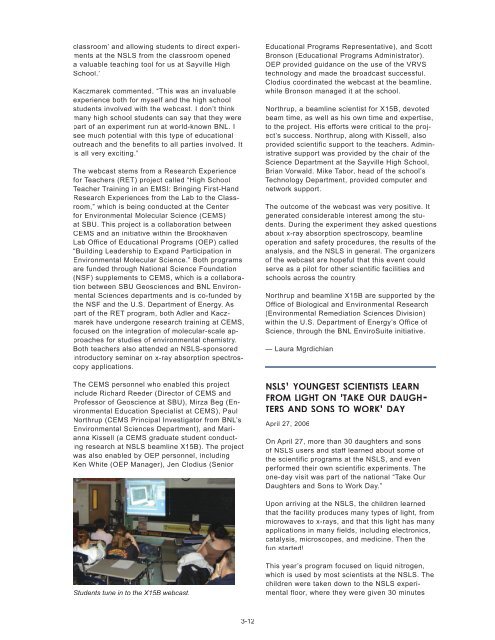NSLS Activity Report 2006 - Brookhaven National Laboratory
NSLS Activity Report 2006 - Brookhaven National Laboratory
NSLS Activity Report 2006 - Brookhaven National Laboratory
Create successful ePaper yourself
Turn your PDF publications into a flip-book with our unique Google optimized e-Paper software.
classroom’ and allowing students to direct experiments<br />
at the <strong>NSLS</strong> from the classroom opened<br />
a valuable teaching tool for us at Sayville High<br />
School.”<br />
Kaczmarek commented, “This was an invaluable<br />
experience both for myself and the high school<br />
students involved with the webcast. I don’t think<br />
many high school students can say that they were<br />
part of an experiment run at world-known BNL. I<br />
see much potential with this type of educational<br />
outreach and the benefits to all parties involved. It<br />
is all very exciting.”<br />
The webcast stems from a Research Experience<br />
for Teachers (RET) project called “High School<br />
Teacher Training in an EMSI: Bringing First-Hand<br />
Research Experiences from the Lab to the Classroom,”<br />
which is being conducted at the Center<br />
for Environmental Molecular Science (CEMS)<br />
at SBU. This project is a collaboration between<br />
CEMS and an initiative within the <strong>Brookhaven</strong><br />
Lab Office of Educational Programs (OEP) called<br />
“Building Leadership to Expand Participation in<br />
Environmental Molecular Science.” Both programs<br />
are funded through <strong>National</strong> Science Foundation<br />
(NSF) supplements to CEMS, which is a collaboration<br />
between SBU Geosciences and BNL Environmental<br />
Sciences departments and is co-funded by<br />
the NSF and the U.S. Department of Energy. As<br />
part of the RET program, both Adler and Kaczmarek<br />
have undergone research training at CEMS,<br />
focused on the integration of molecular-scale approaches<br />
for studies of environmental chemistry.<br />
Both teachers also attended an <strong>NSLS</strong>-sponsored<br />
introductory seminar on x-ray absorption spectroscopy<br />
applications.<br />
The CEMS personnel who enabled this project<br />
include Richard Reeder (Director of CEMS and<br />
Professor of Geoscience at SBU), Mirza Beg (Environmental<br />
Education Specialist at CEMS), Paul<br />
Northrup (CEMS Principal Investigator from BNL’s<br />
Environmental Sciences Department), and Marianna<br />
Kissell (a CEMS graduate student conducting<br />
research at <strong>NSLS</strong> beamline X15B). The project<br />
was also enabled by OEP personnel, including<br />
Ken White (OEP Manager), Jen Clodius (Senior<br />
Students tune in to the X15B webcast.<br />
3-12<br />
Educational Programs Representative), and Scott<br />
Bronson (Educational Programs Administrator).<br />
OEP provided guidance on the use of the VRVS<br />
technology and made the broadcast successful.<br />
Clodius coordinated the webcast at the beamline,<br />
while Bronson managed it at the school.<br />
Northrup, a beamline scientist for X15B, devoted<br />
beam time, as well as his own time and expertise,<br />
to the project. His efforts were critical to the project’s<br />
success. Northrup, along with Kissell, also<br />
provided scientific support to the teachers. Administrative<br />
support was provided by the chair of the<br />
Science Department at the Sayville High School,<br />
Brian Vorwald. Mike Tabor, head of the school’s<br />
Technology Department, provided computer and<br />
network support.<br />
The outcome of the webcast was very positive. It<br />
generated considerable interest among the students.<br />
During the experiment they asked questions<br />
about x-ray absorption spectroscopy, beamline<br />
operation and safety procedures, the results of the<br />
analysis, and the <strong>NSLS</strong> in general. The organizers<br />
of the webcast are hopeful that this event could<br />
serve as a pilot for other scientific facilities and<br />
schools across the country.<br />
Northrup and beamline X15B are supported by the<br />
Office of Biological and Environmental Research<br />
(Environmental Remediation Sciences Division)<br />
within the U.S. Department of Energy’s Office of<br />
Science, through the BNL EnviroSuite initiative.<br />
— Laura Mgrdichian<br />
<strong>NSLS</strong>’ YOUNGEST SCIENTISTS LEARN<br />
FROM LIGHT ON 'TAKE OUR DAUGH-<br />
TERS AND SONS TO WORK' DAY<br />
April 27, <strong>2006</strong><br />
On April 27, more than 30 daughters and sons<br />
of <strong>NSLS</strong> users and staff learned about some of<br />
the scientific programs at the <strong>NSLS</strong>, and even<br />
performed their own scientific experiments. The<br />
one-day visit was part of the national “Take Our<br />
Daughters and Sons to Work Day.”<br />
Upon arriving at the <strong>NSLS</strong>, the children learned<br />
that the facility produces many types of light, from<br />
microwaves to x-rays, and that this light has many<br />
applications in many fields, including electronics,<br />
catalysis, microscopes, and medicine. Then the<br />
fun started!<br />
This year’s program focused on liquid nitrogen,<br />
which is used by most scientists at the <strong>NSLS</strong>. The<br />
children were taken down to the <strong>NSLS</strong> experimental<br />
floor, where they were given 30 minutes

















